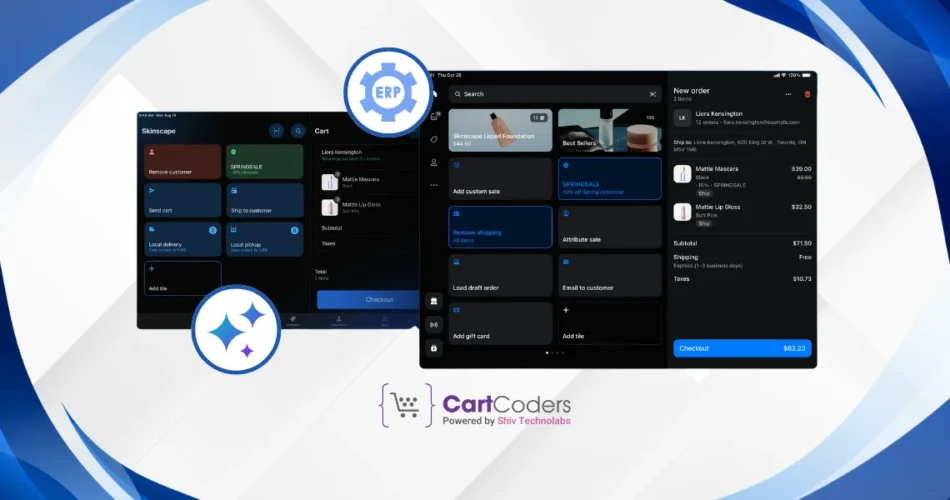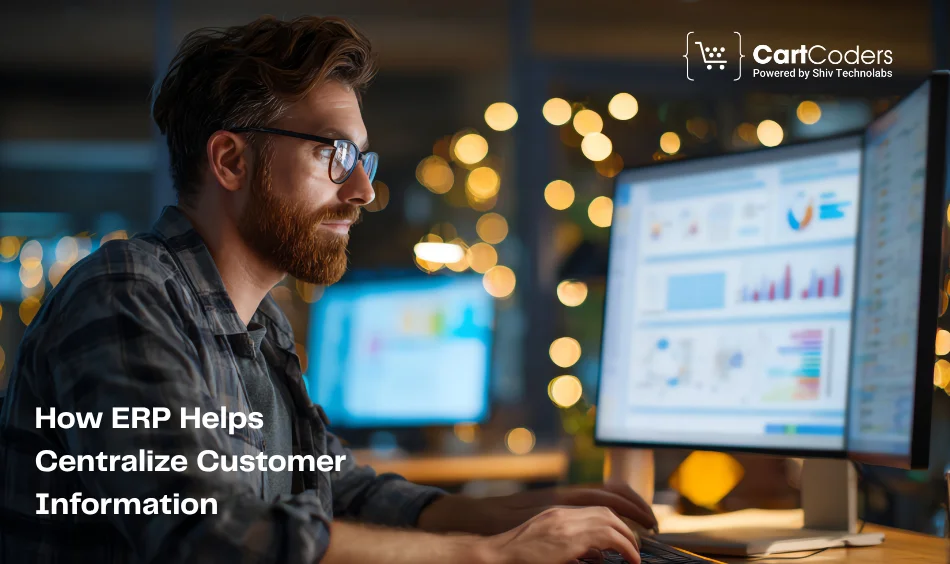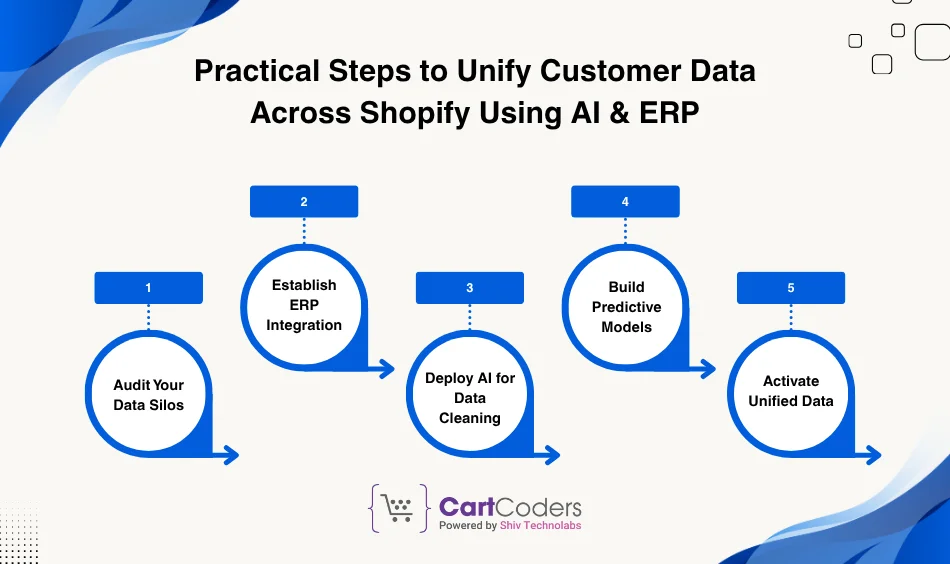Custom Engagement Solutions
Unlock tailored solutions with a free, no-obligation strategy session.
Expert Developers & Engineers on Demand
Scale Your Team with Skilled IT Professionals
Expert Guidance for Digital Transformation

Managing customer data for Shopify merchants is difficult as sales data is in Shopify, invoices are in ERP and customer segments in email marketing tools. This fragmentation leads to duplicate records creation, inconsistent personalisation implementation, and unreliable reporting production that can be costly in terms of revenue and customer trust. The answer? Combining AI with ERP to unify customer data Shopify, merchants collect across all touchpoints.
When AI ERP Shopify integration is perfect you get clear insights who your customers really, and their needs in real time. So how can AI and ERP give Shopify stores a complete customer view that drives growth? Let’s find out.
Your Shopify customer data captures purchases and browsing, but transactions are stored in payment gateways separately. Marketing platforms maintain their own subscriber lists, while CRM systems track support interactions. Meanwhile, inventory, invoicing and sales staff is managed by your ERP system in isolation.
These diverse systems cause particular challenges for those who use Shopify customer data management system:
Issues related to fragmented data in ecommerce are more than just the loss of accurate customer lifetime value, or the ineffectiveness of marketing spend in targeting customers who wants your products / services, but also customer service staff members working without full context. When you cannot unify customer data Shopify with operational systems, every department gets to work on incomplete information.

An ERP system provides the operational backbone storing the financial reality behind every transaction. While Shopify customer data shows what has been purchased by your customers, ERP reveals invoice amounts, payment status, goods returned or warranty claim, products taken back including loyalty credits.
Connecting Shopify data integration with ERP allows easy access to your operational information. Solutions like Odoo Shopify connector has bidirectional flow of the data which guarantees that the inventory updates in your ERP reflect instantly in Shopify, on the other hand a customer order triggers automated invoicing and fulfillment.
However, ERP systems organize and store data brilliantly, but don’t interpret it. Your ERP can tell you what happened, but not why or what will happen next. This is where the AI ERP Shopify combination becomes transformative. ERP keeps your Shopify customer data organized, but AI helps you interpret that data—spotting patterns humans miss and predicting future behavior.
It is true that AI converts a mass of fragmented information into actionable intelligible, making it essential for any Shopify customer data platform strategy.
Identity Resolution: Based on the information in an email address, name, phone number, and behavior, AI algorithms are capable of determining when multiple records represent the same individual. Unlike simple matching, AI in ecommerce data management recognizes that “John Smith” with john.smith@gmail.com is the same customer as “J. Smith” with jsmith@company.com.
Cross-System Data Matching: When you sync customer data Shopify Odoo environments collect, AI creates connections traditional integrations miss. It detects that the newsletter subscriber is the same person who made a guest purchase weeks earlier, then links both to their ERP invoice history.
Predictive Intelligence: AI analyzes unified profiles to identify repeat purchase probability, churn risk signals, product affinity patterns, and optimal communication timing. AI for Shopify personalization creates dynamic segments based on actual behavior rather than static demographics.
Here’s AI in action: A customer abandons their cart. AI cross-references this with ERP data showing they returned their last order, then checks email engagement. Instead of a generic cart abandonment email, AI triggers a personalized message addressing potential quality concerns—turning a potential loss into loyalty.
The difference between fragmented and unified Shopify customer data becomes clear when you compare states:
| Data Layer | Before Integration | After AI + ERP Unification |
| Customer Profiles | Multiple duplicate records; disconnected guest checkouts | Single unified identity; AI-resolved duplicates |
| Order Insights | Only Shopify storefront view | Complete picture with ERP invoices and payment status |
| Marketing | Generic campaigns; manual list building | AI-powered personalization; real-time dynamic segments |
| Inventory | Manual sync; reactive restocking | AI forecasting using unified purchase patterns |
| Customer Service | Only support tickets visible | 360° view showing complete customer journey |
When you successfully unify customer data Shopify stores generate alongside ERP operational data, every team benefits.

Step 1: Audit Your Data Silos
Show or make it clear where the data of the customers of Shopify is currently situated: Shopify, ERP (e.g. Odoo), email platforms, customer service tools and payment processors.
Step 2: Establish ERP Integration
Work with a native connector or APIs to connect your Shopify data integration with ERP. Configure data flow in both directions and real-time triggers for critical updates.
Step 3: Deploy AI for Data Cleaning
AI powered tools can be used to clean up current records, merge duplicates and transcribe missing data before the information unification step.
Step 4: Build Predictive Models
Train AI models for predicting customer lifetime value, churn scoring and also products recommendations so as to turn your Shopify customer data platform into a proactive growth engine.
Step 5: Activate Unified Data
Push unified, AI-enhanced profiles to operational systems. Enable email marketing with complete purchase history and give customer service teams’ 360° views.
A mid-sized skincare brand on Shopify with Odoo managing backend operations faced a problem: 40% of their customer database consisted of duplicates. Before implementing AI ERP Shopify integration, email campaigns treated duplicate profiles as separate customers, causing some to receive three identical emails while others received none.
They deployed an Odoo Shopify connector to sync customer data Shopify Odoo systems held, then used machine learning to analyze patterns and identify duplicates with 95% accuracy. The AI unified customer data ecommerce systems captured.
Results Within Six Months:
This demonstrates that unified data directly translates into personalized experiences and measurable business results.
Enhanced Marketing Precision
Consistent Cross-Channel Experience
Accurate Analytics
Operational Efficiency
Business Metrics Impact:
Ignoring Data Hygiene: Always run AI-powered cleansing before connecting systems. Your Odoo Shopify integration will be more accurate starting with clean Shopify customer data.
Over-Reliance on Plugins: Installing an Odoo Shopify connector doesn’t automatically unify customer data Shopify merchants need. Configure field mapping and train AI models on your specific patterns.
Departmental Silos: Include all stakeholders in defining requirements for your AI ERP Shopify strategy.
Insufficient AI Training: AI for Shopify personalization requires training data. Plan for a learning period after you sync customer data Shopify Odoo systems generate.
For Shopify merchants who are looking to unify customer data ecommerce that businesses generate, Odoo is the best choice. The Odoo Shopify integration creates a focal point as Odoo combines sales, inventory, accounting, CRM and marketing in one platform.
When you sync customer data Shopify Odoo environments environments share, orders flow automatically across the network and subsequently an invoice is generated. AI-driven auto-reconciliation along with predicting purchases, personalized retargeting, intelligent inventory allocation etc can also be implemented on this foundation.
In current e-commerce environment, the main competitive advantage is to be able to understand your customers better than anyone else which is impossible if you have fragmented data. AI and ERP are contrastive superpowers: ERP provides structure for your Shopify customer data while AI will give intelligence for interpreting patterns and automating personalization system.
When you successfully unify customer data Shopify generates, enhanced by AI in ecommerce data analytics and grounded in ERP operational reality, you transform from reactive order-taking to proactive customer service. The investment in AI ERP Shopify integration—particularly through Odoo Shopify integration—pays compounding dividends over time.
Ready to transform your Shopify customer data platform? Start by connecting with Cartcoders team who are experts in auditing data silos, connecting systems with proven Shopify data integration with ERP solutions, and layering AI for Shopify personalization to unlock predictive insights.
A unified profile combines all customer data Shopify captures with information from ERP systems, marketing tools, and customer service platforms. AI resolves duplicates to create a single, complete view.
Yes—ERP systems like Odoo store operational data, while AI analyzes patterns and resolves duplicates. The combination enables both accurate management and intelligent insights.
AI algorithms analyze multiple data points to identify when different records represent the same customer, recognizing variations and patterns that indicate identity matches even when data doesn’t exactly match.
Shopify data integration with ERP makes the manual data entry obsolete and provides real time inventory sync, enables accurate financial reporting by customer, unifies customer profiles with sales and operations and creates groundwork for AI powered personalization and predictions.
There are AI algorithms which can analyze many data points such as names, email addresses, shipping/billing addresses, phone numbers, and customer patterns to differentiate between when different data records represent the same customer. Contrary to rule-based techniques which may not easily detect variations and there can be a match pattern which is not identical to the search pattern.
Projects delivered in 15+ industries.
95% retention rate, building lasting partnerships.
Serving clients across 25+ countries.
60+ pros | 10+ years of experience.